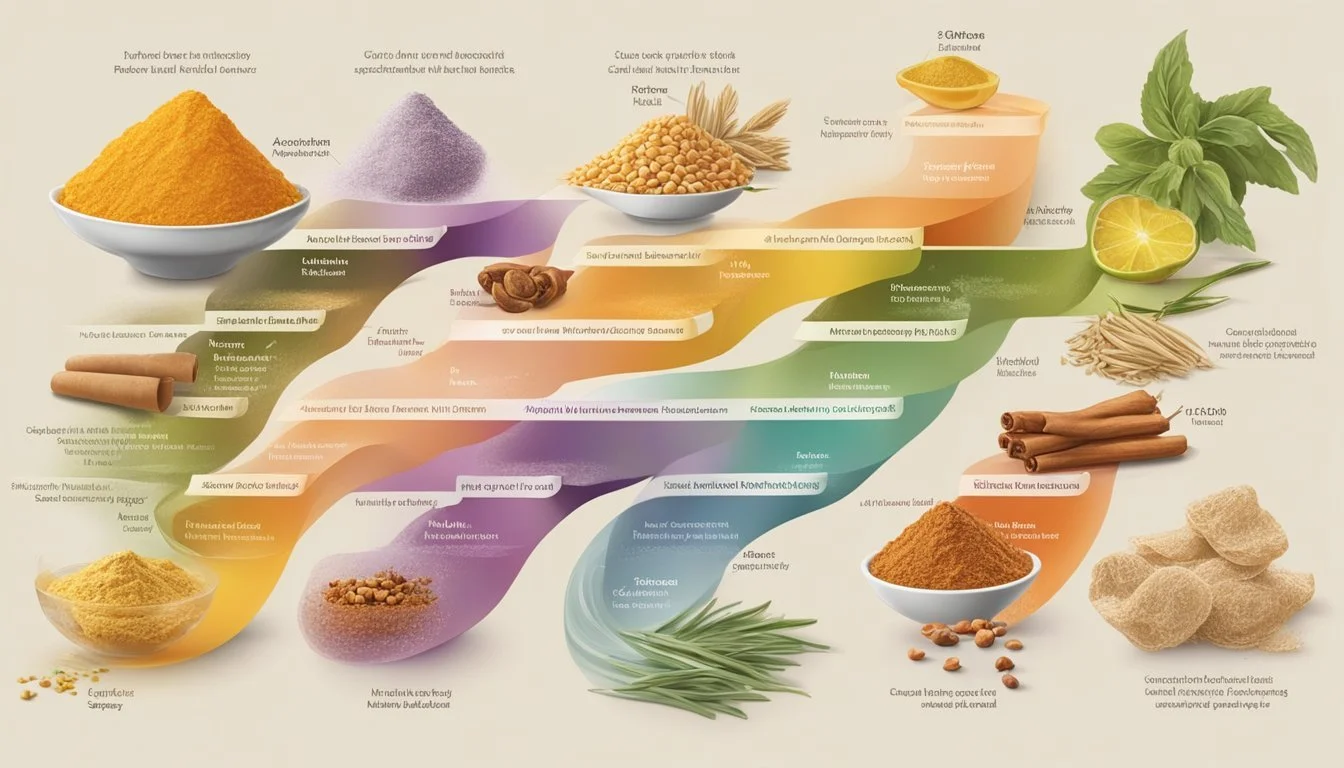Swicy History Unwrapped
The Evolution of Sweet-Spicy Flavors
The concept of 'swicy' flavors, a blend of sweet and spicy, has become increasingly prominent in culinary circles. This trend highlights a long-standing human fascination with the complex interplay of flavors that challenge and stimulate the palate. Historically, many cultures have independently explored the balance of sweetness with heat in their traditional cuisines, resulting in a variety of dishes that excite the taste buds through contrasting yet complementary sensations.
In recent years, the food industry has seen a surge in the popularity of 'swicy' options, with inventive chefs and food brands combining sugar and spice in new and exciting ways. The rising demand for these flavors can be traced back to the inherent sensory experience they provide, often amplifying the depth and richness of dishes. The sweet component typically acts to smooth out the intensity of spicy ingredients, creating a more rounded and enjoyable taste experience.
Market research indicates a significant increase in menu offerings that boast this sweet-spicy fusion. With a notable rise in creative culinary applications, such as the use of hot honey and spicy jams, 'swicy' flavors have successfully managed to capture and retain consumer interest. This culinary movement is not just about novelty; it also reflects a nuanced understanding of flavor profiles and how they can be harnessed to elevate the dining experience.
Origins and History of Sweet-Spicy Flavors
The blending of sweet and spicy flavors, often referred to as "swicy," has a deep history, with roots tracing back to ancient civilizations. Xocoatl, an early form of hot chocolate, exemplifies one of the earliest combinations of these flavors. The Aztecs valued this beverage, which they made from cacao beans, chili peppers, and other spices, without the sugar that modern palates expect. This drink was not just a delicacy but also played a role in ceremonial and medicinal contexts.
The use of chili peppers, which are native to the Americas, has been central to sweet-spicy cuisine. Chilis have the heat-inducing properties that characterize the "spicy" aspect of swicy flavors. Once the Columbian Exchange introduced new world ingredients like the chili to other parts of the globe, the interaction between spiciness and sweetness evolved. Alternative forms of sweetness such as honey, fruit, and, later, cane sugar began to mark the culinary landscape by offsetting the heat of the chili.
The integration of chocolate into this mix, especially following its spread to Europe, showcased the potential of sweet and spicy combinations. European adaptations began to include sugar, creating a familiar sweet profile, contrasted by the incorporation of hot spices like chili, cinnamon, and nutmeg, forming a precursor to today's swicy sensations.
As the appreciation of contrasting flavors grew, so did the experimentation and integration of sweet and spicy ingredients. Cooks and food aficionados across the globe have found distinct ways to merge these flavors into unique culinary experiences—transforming what once was an ancient practice into a trend that persists in various forms today.
The Science of Swicy: Understanding Taste
This section dissects the complex interaction between sweet and spicy flavors, how they are perceived by taste buds, and their impact on sensory experience.
The Role of Capsaicin in Spiciness
Capsaicin is the chemical responsible for the spicy sensation in foods, activating specific receptors in the mouth. These receptors, known as TRPV1, are usually triggered by heat. When capsaicin binds to these receptors, they send signals to the brain that mimic physical heat, resulting in the characteristic spice-induced warmth.
Sugar's Effect on Heat Perception
Sugar interacts with spiciness by affecting the sensation of heat. When sugar is present together with capsaicin, it can lessen the receptor's response, thereby decreasing the perceived intensity of spiciness. Sweetness often acts to balance the aggressive heat sensation, creating a more palatable tasting experience known as swicy.
Taste Buds and Sensory Experience
Taste buds play a central role in detecting the five basic tastes: sweet, sour, salty, bitter, and umami. Spicy is not a taste but a sensation; it is a pain signal sent to the brain. The combination of sweet and spicy, or swicy, engages multiple sensory pathways. This can stimulate the release of endorphins, leading to feelings of pleasure. In such encounters, taste buds not only discern flavors but also contribute to a comprehensive sensory experience.
Swicy in Modern Cuisine
In recent years, swicy flavors have established themselves as a significant trend in modern cooking, influencing chefs and menus globally with their dynamic flavor combinations of sweetness and heat.
Sweet-Spicy Fusion in Recipes
Chefs are increasingly experimenting with swicy flavors across a variety of dishes. For example, Korean cuisine often features recipes with a balance of the two sensibilities, such as the famous Korean fried chicken, which is typically coated in a sweet heat glaze. The swicy effect is achieved through the familiar, satisfying taste of sugar combined with the exciting punch of chili.
Key Ingredients for Swicy Fusion:
The Rise of Swicy Dishes in Restaurants
Restaurants are weaving swicy flavors into their menus more frequently. With a demand increase of 38% in recent years, dishes offering sweet heat are not just a fleeting fancy but a solidified flavor trend. Hot honey and other swicy condiments have transitioned from niche to mainstream, becoming a staple in food establishments aiming to keep pace with current tastes.
Popular Swicy Restaurant Dishes:
Appetizers: Swicy glazed wings
Mains: Sweet-spicy barbecue ribs (What wine goes well with barbecue ribs?)
Sides: Spicy candied vegetables
Sweet and Spicy Desserts
The swicy trend has even expanded into desserts, a territory traditionally dominated by the purely sweet. Dessert items like cake infused with spicy elements or ice cream with a hint of chili have garnered interest from those seeking new and intriguing flavor combinations. This sweet-spicy foray allows for a complex taste experience that challenges and delights the palate.
Innovative Swicy Dessert Examples:
Cake: Chocolate lava cake with a hint of cayenne
Ice cream: Mango sorbet with a swirl of chili-infused syrup
Cultural Influence and Popularization
In exploring the evolution and impact of sweet-spicy (swicy) flavors, one uncovers a rich tapestry of cultural integration and the rise of a global trend through social engagement, bolstered by the influence of younger generations.
Sweet-Spicy Across Different Cultures
Sweet and spicy flavor combinations can be traced across various culinary traditions. In Mexico, chamoy sauce combines apricot, lime, and chilies for a distinctive swicy taste, often paired with mango slices and sprinkled with tajín, a chili-lime salt. Korea offers gochujang, a fermented condiment blending sweet rice, fermented soybeans, and red chili pepper, essential in many traditional dishes. Southeast Asia's nuoc cham, a sweet and spicy dipping sauce, integrates fish sauce with sugar and lime, incorporating the heat from jalapeño peppers. These flavors signify not only a blend of sweet and spicy but also represent collective cultural identities and gastronomic heritage.
Swicy on Social Media Platforms
On platforms like TikTok, swicy flavors have surged in popularity. Users share recipes and food experiences that highlight the fusion of sweet and spicy. Influencers like Andrea Ramirez, who embrace their culinary heritage, often showcase traditional dishes such as mango with tajín or innovative swicy creations, contributing to the flavors' viral allure. TikTok's hungry audience rapidly disseminates these trends, solidifying swicy combinations as a mainstay in digital food culture.
Influence of Millennials and Gen Z
Millennials and Gen Z have played a pivotal role in the popularization of swicy flavors. Attracted to novel and global culinary experiences, these generations champion diversity in their palates. They tend to embrace the concept of portmanteau names, like 'swicy', that offer a succinct and catchy way to describe complex flavor profiles. Through their buying power and social influence, millennials and Gen Z have elevated swicy from a niche trend to a commonplace desire on restaurant menus and in consumer products.
Market Evolution and Consumer Behavior
The interplay of sweet and spicy flavors, often termed 'swicy', has seen marked growth in the food industry, guided by detailed market research and shifting consumer inclinations.
Industry Insights and Market Research
Market research firms like Datassential have documented a 38% increase in menu appearances of sweet and spicy pairings within a year, a trend exemplified by the rise of hot honey. Brands such as Monin and Torani are also capitalizing on this trend, adapting their product lines to meet the swicy demand. Mintel, another market research powerhouse, supports these findings, revealing that a significant majority of American consumers express interest in sweet and spicy sauces.
Consumer Trends and Preferences
Consumers are increasingly drawn towards the swicy flavor profile, with hot honey and hot pepper jelly becoming especially popular in both retail and foodservice sectors. Analysis indicates a notable preference among Millennial and Gen Z consumers for flavors that marry sweet with heat, surpassing the traditional sweet, sour, and umami taste dimensions. These preferences reflect a broader evolution of the palate, where spicy food (What wine goes well with spicy food?) is no longer a niche but a well-embraced component of modern eating habits.
Product Innovations and Brand Examples
The swicy flavor trend has seen a surge of innovation within the food industry, leading to the creation and adaptation of a range of products across various brands. This section explores specific swicy products and the brands that have been instrumental in driving this culinary movement forward.
Notable Swicy Products
Pizza: Pizza Hut has capitalized on the swicy trend by introducing pizzas that incorporate sweet chili sauce, offering a balance of flavors that has become popular among consumers.
Condiments: Cowboy Candy, candied jalapeños, combine the heat of peppers with a sugary coating, while hot sauces often infuse sweetness to temper fieriness.
Snacks: Takis, known for their rolled tortilla chips, have varieties that blend the sharpness of lime and heat of chili, adding a subtle sweetness that enhances their punch.
Beverages: Jalapeño margaritas are a stellar example of swicy, merging the spiciness of jalapeños with the sugary content of margarita mix.
Desserts: The tradition of Mexican hot chocolate integrates cocoa with spices like cinnamon and sometimes even chili to create a warm, swicy experience.
Brands Leading the Swicy Movement
Fast Food: Burger King and Chick-fil-A have introduced menu items like spicy chicken sandwiches with sweet heat sauces, incorporating habanero and other peppers into their recipes for a swicy kick.
Casual Dining: Outback Steakhouse has offered swicy flavors through dishes like their honey sriracha back ribs, mingling sweetness with a spicy sriracha glaze.
Seasonings: Tajin, a seasoning brand, represents the swicy concept with its blend of chili peppers, lime, and salt, often used to dress fresh fruits for an explosive flavor combination.
Noodles: Instant and ready-to-cook noodle brands have embraced swicy by infusing sweet flavors like brown sugar with traditional hot spices.
By continuously innovating and experimenting with swicy flavors, these products and brands have not only satisfied the evolving palette of consumers but have also set a benchmark for taste innovation in the culinary space.
The Future of Sweet-Spicy Flavors
The landscape of culinary preferences is ever-evolving, with sweet and spicy flavors having carved a niche in both home kitchens and restaurant menus. This balance of sugar and heat is not just a fleeting moment; it's an enduring flavor trend. Industry insiders predict a continuance of this trajectory as consumers pursue the thrilling interplay of spiciness and sweetness.
Sweet-spicy combinations harness the heat of compounds like capsaicin found in chili peppers, paired with sugary notes to create a satisfying balance. The reaction in our bodies to this mix is a release of endorphins, leading to a sense of pleasure.
Moving forward, we can anticipate the food industry to capitalize on the Swicy trend by exploring novel ingredients and pairings. For example, the numbing heat of Szechuan pepper may find its way into more palates globally, captivating those eager for new experiences.
Trend Influences Predicted Impact Capsaicin-rich foods Increased popularity Sugar counterparts More diverse options Consumer demands Rise in Swicy products
One can expect spork-like innovations—utensils merging form and function—wherein the food itself becomes a hybrid of contrasting tastes. The warming sensation of spices alongside cooling sweet elements will likely manifest in innovative desserts and beverages.
As tastes continue to evolve and intermix, the appeal of sweet and spicy endures, suggesting that Swicy flavors will remain prominent on tomorrow's cuisine landscape, inviting diners on a taste adventure that excites as much as it comforts.
Pairings and Experiments with Swicy
The swicy trend has reveled in culinary courage, marrying the unexpected sweetness with a spicy kick that has found its way into numerous dishes and beverages. This section explores the inventive blend of sweet-spicy flavors across different pairings, particularly within the realm of cocktails and innovative food combinations.
Swicy in Cocktails
Concocting spicy cocktails has become an art form for many mixologists, who are increasingly experimenting with adding a swicy twist to their creations. The interplay of sweet heat and bold spices adds complexity and an enticing sensory experience that engages more than just the palate.
Mangonada: A beverage that epitomizes swicy, combines sweet mango with chili powder and sometimes incorporates tamarind for an added layer of sweetness and tartness.
Spicy Margaritas: These often feature bold hot peppers such as jalapeños or habaneros, which are muddled or infused into the drink, complemented by sweetness from agave syrup or fruit purees.
In the execution of swicy cocktails, balance is key. Each ingredient must be measured precisely to ensure that the sweetness harmonizes with the spice, neither overwhelming the other.
Creative Swicy Combinations
Beyond beverages, swicy flavors are being infused into a myriad of culinary dishes, expanding the concept of umami with their sensory experience. Chefs are keen to explore sweet spices and spicy sweets in novel pairings that offer not only a burst of flavor but also the element of surprise and pleasure.
Popular pairings include:
Hot Honey on pizza or fried chicken, delivering an ideal mix of soothing sweetness and awakening heat.
Chili Chocolate, combining rich, velvety chocolate with a warm spice that lingers on the tongue.
These combinations reflect a boldness in culinary experimentation, highlighting the versatile nature of swicy flavors that can be adapted to both savory and sweet contexts.
Understanding Swicy's Place in Health and Wellness
In the realm of health and wellness, 'swicy' foods have found their niche due to their unique interplay between spiciness and sweetness. These ingredients target various taste buds and sensory experiences. Capsaicin, the active component in chili peppers that imparts spiciness, is significant for its effects on the body. It not only introduces a perceived heat but also stimulates the release of endorphins, the body's natural pleasure-inducing chemicals. This release can provide a sense of well-being and satisfaction to those who consume spicy foods.
Sweet components are often used in swicy food pairings to create a balance against the heat from capsaicin. By countering spiciness, the sweet flavors can enhance the overall sensory experience, making spicy foods more palatable and enjoyable. Incorporating both flavors not only broadens the sensory appeal but can also mitigate the intense heat for those with more sensitive palates.
Chilis and their spiciness are measured on the Scoville scale. Consumers interested in swicy foods can use the scale as a reference to determine the heat level of different chilis and select a balance that suits their own health and comfort levels.
In terms of health, this sweet and spicy combination might offer a varied spectrum of flavors while promoting moderation. Instead of overwhelming the dish with high levels of spice that only a few can enjoy, the swicy approach allows more individuals to engage in the savory complexity of these flavors without discomfort.
How to Incorporate Swicy into Your Cooking
Incorporating swicy flavors into cooking invigorates dishes with a harmonious balance of sweet and spicy sensations. With the right ingredients and techniques, home cooks can master this appealing taste combination that has captivated palates across generations.
Home-Cook Friendly Swicy Recipes
For those eager to explore swicy flavors at home, here are a couple of straightforward recipes:
Swicy Glazed Chicken: Marinate chicken thighs (What wine goes well with chicken thighs?) in a mixture of brown sugar, soy sauce, garlic, and chopped hot peppers. Bake until caramelized and serve with rice.
Pineapple Swicy Salsa: Combine diced pineapple with minced hot peppers, a dash of lime juice, and a sprinkle of brown sugar. This salsa adds a swicy kick to grilled fish or tacos.
Tips for Balancing Sweet and Spicy
Crafting the perfect swicy combination means finding the right balance between heat and sweet. Here's how:
Start Small: Begin with a modest amount of spicy elements like hot pepper; you can always add more to intensify the heat.
Brown Sugar: It mellows the spiciness while contributing a deep, molasses-like sweetness, perfect for creating a swicy profile.
Taste Testing: Continuously sample your dish while cooking to ensure a harmonious swicy profile is achieved, adjusting as necessary.
Conclusion
The evolution of 'swicy' flavors represents a culinary trend with rooted historical preferences. The balanced combination of sweetness and spice has always had its place in various cuisines. Recently, it has been embraced with enthusiasm, particularly among younger demographics.
Market Growth: The 'swicy' trend has witnessed significant market growth, thanks to innovative food and beverage products.
Consumer Enjoyment: The reason for its popularity lies in the sensory experience it provides. The mix of sugar and spice not only delivers a unique taste but also triggers the release of endorphins, contributing to a pleasurable eating experience.
Innovation Potential: Moving forward, the fusion of sweet and spicy opens avenues for further culinary exploration. New combinations are being experimented with, promising a future of exciting flavor profiles.
Their prevalence is a testament to the timeless appeal of combining opposing flavor profiles, which continues to be a driving force in the food industry. As consumer tastes evolve, 'swicy' flavors are likely to persist as a prominent part of menus and products, underlining the human desire for diverse and complex taste experiences.









